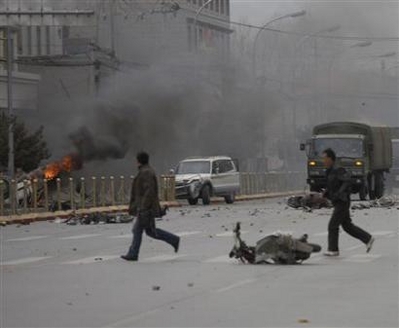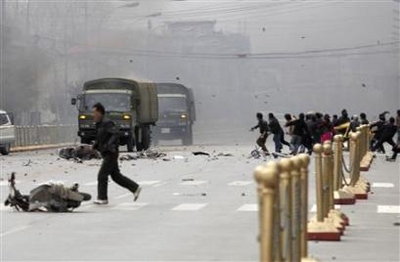Tibet, China and the information gaps between
Despite the approaching Olympic Games, it should come as no surprise to most observers of China that information about the spreading protests in Tibet (Autonomous Region) and other far western provinces is subject to vigorous censorship. YouTube enables certain actors actors to determine geolocational filtering by country, but the Chinese government chose to block the entire site on March 15. Some Western media outlets and various other websites, have reportedly become inaccessible in the week since the protests began.
As with the government crackdown in Burma last fall, the surge in video footage and images of the protests likely prompted the Chinese to block Youtube on March 15. However, the political context of these protests is more nuanced than in Burma, where the repressive military junta attacked civilians and monks who were, by all accounts, protesting peacefully. Reports of ethnic Han Chinese being attacked and targeted by Tibetans have incensed many Chinese netizens. The chatter goes in all directions, but one dominant strain of discussion accuses the West of carrying on a dialogue on Tibet that is just as one-sided as the censored version in China. Others contend that the truth lies in the gray zone between the information machines of Beijing and Dharamsala.
See blogger Roland Soong’s side-by-side comparison of the uses of the same photo used to portray different perspectives.

One rarely encounters a Chinese citizen who believes Taiwan should have its independence, and the same goes for Tibet—with a twist. People often criticize China’s involvement in Tibet because of the perception that Tibet policy diverts precious state resources to a people who were liberated from the feudal practices of the Dalai Lama’s government but don’t even appreciate it—a burden without adequate reward. Rebecca MacKinnon points out in this great post that this popular sentiment plays itself out in the Chinese online space as well. In practice, China has increasingly implemented policies of economic, cultural, religious and political marginalization and exclusion in its ethnic “autonomous regions.”
YouTube has become a terrain for publicizing and presenting dimensions of conflict, including Israel-Palestine, Armenian-Azeri, Estonia-Russia, and Turkey-Greece. While the ability of a filtered YouTube to serve as a political battleground around Tibet has been diminished, it is one of the few sites where a “propaganda” war could really be waged. For example, one overseas Chinese has eagerly jump into the fray with aggressive YouTube/online media strategies. As the Associated Press reported, the major domestic online video providers, including Tudou and 56.com, are scrubbed clean of protest footage, and instead tend to feature glossy images of Tibetan folk culture and music. Furthermore, domestic Internet censorship, including keyword filtering in chat rooms and discussion boards, aims to cull not only positive portrayals of the Dalai Lama and Tibet, but all discussion on the topic.
There seems to be a growing expectation that cell-phone videos and other cheap forms of participatory media are important and will provide vital streams of information regarding fast-erupting and volatile world events (see this video where the reporter is being filmed next to a monk taking images with his cell phone). In an era when users have become accustomed to the added impact of these forms of documentation, the relative dearth of eyewitness video and photographic accounts in Tibet have not gone unnoticed. These could be disproportionately valuable in a region highly restricted for journalists. Though Chinese authorities were not able to achieve control over the protests or prevent other forms of damage, their skill in controlling domestic media and tampering with online expression is apparent.



